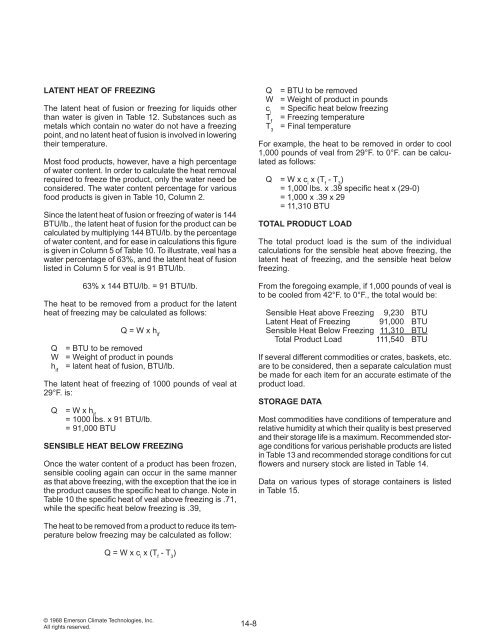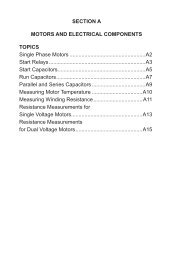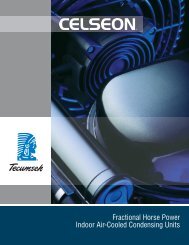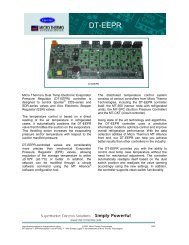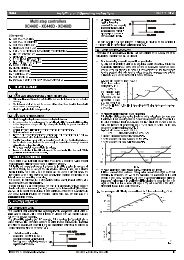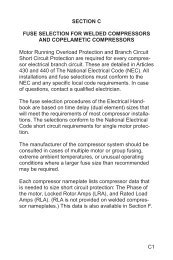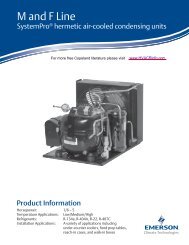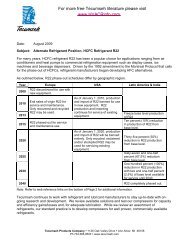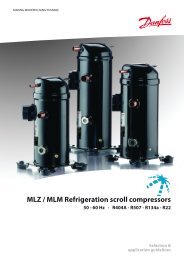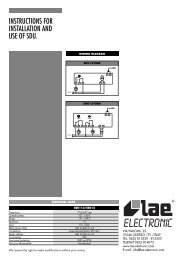The Refrigeration Load - HVAC and Refrigeration Information Links
The Refrigeration Load - HVAC and Refrigeration Information Links
The Refrigeration Load - HVAC and Refrigeration Information Links
Create successful ePaper yourself
Turn your PDF publications into a flip-book with our unique Google optimized e-Paper software.
LATENT HEAT OF FREEZING<strong>The</strong> latent heat of fusion or freezing for liquids otherthan water is given in Table 12. Substances such asmetals which contain no water do not have a freezingpoint, <strong>and</strong> no latent heat of fusion is involved in loweringtheir temperature.Most food products, however, have a high percentageof water content. In order to calculate the heat removalrequired to freeze the product, only the water need beconsidered. <strong>The</strong> water content percentage for variousfood products is given in Table 10, Column 2.Since the latent heat of fusion or freezing of water is 144BTU/lb., the latent heat of fusion for the product can becalculated by multiplying 144 BTU/lb. by the percentageof water content, <strong>and</strong> for ease in calculations this figureis given in Column 5 of Table 10. To illustrate, veal has awater percentage of 63%, <strong>and</strong> the latent heat of fusionlisted in Column 5 for veal is 91 BTU/lb.63% x 144 BTU/lb. = 91 BTU/lb.<strong>The</strong> heat to be removed from a product for the latentheat of freezing may be calculated as follows:Q = W x h ifQ = BTU to be removedW = Weight of product in poundsh if= latent heat of fusion, BTU/lb.<strong>The</strong> latent heat of freezing of 1000 pounds of veal at29°F. is:Q = W x h if= 1000 lbs. x 91 BTU/lb.= 91,000 BTUSENSIBLE HEAT BELOW FREEZINGOnce the water content of a product has been frozen,sensible cooling again can occur in the same manneras that above freezing, with the exception that the ice inthe product causes the specific heat to change. Note inTable 10 the specific heat of veal above freezing is .71,while the specific heat below freezing is .39,Q = BTU to be removedW = Weight of product in poundsc i= Specific heat below freezingT f= Freezing temperatureT 3= Final temperatureFor example, the heat to be removed in order to cool1,000 pounds of veal from 29°F. to 0°F. can be calculatedas follows:Q = W x c ix (T f- T 3)= 1,000 lbs. x .39 specific heat x (29-0)= 1,000 x .39 x 29= 11,310 BTUTOTAL PRODUCT LOAD<strong>The</strong> total product load is the sum of the individualcalculations for the sensible heat above freezing, thelatent heat of freezing, <strong>and</strong> the sensible heat belowfreezing.From the foregoing example, if 1,000 pounds of veal isto be cooled from 42°F. to 0°F., the total would be:Sensible Heat above Freezing 9,230 BTULatent Heat of Freezing 91,000 BTUSensible Heat Below Freezing 11,310 BTUTotal Product <strong>Load</strong> 111,540 BTUIf several different commodities or crates, baskets, etc.are to be considered, then a separate calculation mustbe made for each item for an accurate estimate of theproduct load.STORAGE DATAMost commodities have conditions of temperature <strong>and</strong>relative humidity at which their quality is best preserved<strong>and</strong> their storage life is a maximum. Recommended storageconditions for various perishable products are listedin Table 13 <strong>and</strong> recommended storage conditions for cutflowers <strong>and</strong> nursery stock are listed in Table 14.Data on various types of storage containers is listedin Table 15.<strong>The</strong> heat to be removed from a product to reduce its temperaturebelow freezing may be calculated as follow:Q = W x c ix (T f- T 3)© 1968 Emerson Climate Technologies, Inc.All rights reserved.14-8


